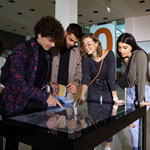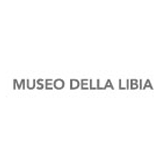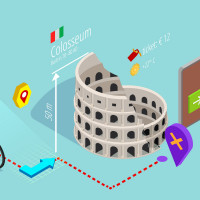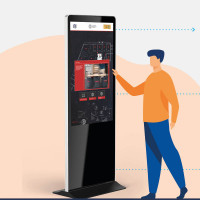
CULTURAL HERITAGE
Culture heritage becomes an experience
Solutions to attract visitors, entertain them and inform them through digital engagement.

Touchwindow ® developed the technological installation of the Museum of Libia, and worked in collaboration with the Architettura Crachi Studio since the first steps of the planning of the Museum, in the choice of the technologies and devices to be installed.
The museum project development was dividend in three main steps by Touchwindow ®: the first step was dedicated to the trips to Libia for the iconographic research e and the filming of the videos, 3D laser scans of statuesand virtual reconstructions of the archaeological sites.
In the second step, the hardware e software were developed with the programming of the interactive systems and the creation of multimedia devices through with visitors can explore the subject exposed,go into more depth, manipulate images and environments, statues or findings that are not physically in the museum. The third step regarded the preparation of the Museum where Touchwindow ® took care of the production and installation of: 20 wall projections, 8 holographic projections and interactive holograms, 4 interactive holographic stands, 1 interactive carpet, 2 architectural projections, 2 screen less particellar projections,10 interactive sound domes, multi area wireless audio system, 2 server rooms and 2 data racks, all the network cable and wireless system, 16 interactive LCD monitor installed on Totems or wall-mounted, 4 interactive stands, 35 scent diffusers and the entire network infrastructure needed to access and manage every device remotely.In order to get connected with all the devices from the 2 control rooms, 5000m of wires have been used and installed on walls of the Maltauro Group, and more than 2000m of wire on the hanging rails.
During the first phase of the work, the Touchwindow ® technicians traveled to Libia together with directors and archaeologists to collect the contents eventually used for the production of videos, virtual reconstructions and multimedia applications. Directors and archaeologists visited the most interesting sites in Libia: Sabratha, Leptis Magna and Cyrene to the most remote locations in the desert of Ghirza and Ghadames to film and process the virtual reconstruction of the area.Touchwindow ® developed the production and post-production of the several videos projected in the museum rooms, the audio content in different languages and the coordination together with the archaeologist of the sites virtual reconstructions.
The videos produced were used as visual completion of the exposition and to better explain the subjects presented. Many projections have audio contents played by sound domes that are activate only when a visitors is nearby. Thanks to this technology, only who is below the dome will be able to listen the audio recording, while the other visitors can enjoy the exhibition undisturbed.
Technicians used laser scanners to scan statues and ancient mausoleums, to create representations of artworks and areas, otherwise impossible to see or visit by the visitors. The 3D laser scanner, a reader, scanning and detection device, was used to develop tridimensional models of statues and archaeological findings. Using this device, 3D representations of artworks that are physically placed hundreds of kilometers far from the museum, can be seen and discovered.
Hardware e Software were developed during the second phase. Touchwindow ® took care of the processing and editing of videos, images and graphs tocreate interactive videos, projections and animations and the multi sensorial applications in the museum interactive devices.
Touchwindow ® implemented holographic transparent screens (interactive and non-interactive), that displayed videos and virtual routes, 3D representations of virtual environments and archaeological areas, or holographic representations of certain findings.
The holographic technology used by Touchwindow ® for the Museum of Libia is a true optical screen and not a transparent diffusion screen. It’s a screen composed by thousands of holographic prisms angled to receive the light from the projector. In this way the screen only receives the light from the projector, excluding other sources of light, concentrating the light to the visitors point of view. This offers a brightness from 2 to 4 times higher then diffusion screens, an excellent contrast and extremely high viewing angle. Thanks to this sophisticated technology, the objects displayed on those screens appear as floating on air, giving the illusion of a 3D effect.
Interactive stands with touch screen monitors are used to browse the green and the white book, to view thematic videos related to the actual expositions.
Touchwindow ® prepared virtual reconstructions with immersive projections: exhibition rooms with projections covering the entire walls, and the visitor is surrounded by animated virtual environments and has the feeling to actually be in that place. Sophisticated devices release nebulized particles that are hit by the light of a projector, creating screen-less projections floating on air that appear as 3d objects. Visitors can touch, manipulate and move through those holograms creating extraordinary visual effects. Every interactive application, starting from the touch screens, transparent holographic screens, interactive carpets to the architectural projections, is controlled by a powerful Digital Signage Software customdeveloped and installed in the Control Room. With this software, the museum employees can control the diagnostic of each device installed in the exhibition room, update contents to create new thematic routes.
The multimedia application designed and developed by Touchwindow ® allow visitors to discover the most beautiful and famous sites in Libia through virtual navigation routes. Virtual interactive panoramas of archaeological sites were created using particular cameras: with this technology, users have the illusion to actually be in that environment. The virtual panoramas displayed by the visualization software are connected to one another creating a continuous environment where visitors can move from one area to the next one, offering a true interactive navigation. Each time the visitor changes the view of a scene using the touch screen, the program maintains the right perspective giving the impression to be walking in the archaeological site.
Each multimedia application has been realized in the two main languages spoken, Arabic and English: users can change the desired language in the interactive devices, to obtain more detailed information.
Touchwindow ® took care of the entire process of ideation, designing and development of the multimedia projects displayed by the devices installed in the Museum. This complex phase of production was divided into three main phases: design, to draw the project guidelines, determine the rules for the devices production and technologies to be used to the content processing. The team of Touchwindow ® experts was in charge of the content processing and adjustment to the required standards, audio system, graphic design of the several projects and coordination of the entire whole design following the directions from historicals and archaeologists.
During the editing process, Touchwindow ® programmed each system from beginning to end, created the browsing interfaces, the video and the multimedia contents.
Building the framework of a multimedia project is a complicated job that requires an accurate and careful understanding of the project as a whole, and its navigation framework. Only in this way the interactive solution will comply with the usabitliy standards and will be entirely comprehensible by the users that are now able to orientate themselves through the application and understand its active contents. The reading processes of a printed book are represented by the interactive applications following a multi directional logic that creates several studies and unique reading processes based on the potentials offered by the external and internal links accessible by multi touch devices.
Touchwindow ® studied and developed design models for the museum Edutainment software with user-friendly interfaces where the user is completely immersed using touch screen technologies needed to achieve the man-machine relationship and create dynamic learning systems and constitutive routes.
Every single interactive technology developed and installed in the Museum have been designed with the intent of creating educational and reharsal areas, vibrant learning routes and fully customizable. Visitors are able to follow their personal route, a fruitive dynamic process where it’s possible to choose different ways of experience, different levels of examination of the subjects and manyintroductory stimulus.
In conclusion, the Museum of Libia has all the features of a so called Multi Sensorial or Interactive Museum; nowadays Museums are turning from simple storages of artifacts to active places that offer more information, emotive involvement and added values to the visitors experience.
The Museum of Libia represent a learning and cognitive route not only based on passive exposition of findings and artifacts, but also using technological devices, touch screen, immersive and particellar projections, offering scientific contents and emotive involvement to teach, deepen the subjects and amuse the visitors.

Solutions to attract visitors, entertain them and inform them through digital engagement.

The challenges of the Digital Transformation to bring greater value to Italy's national territory. Is the Public Administration ready?

LIFE, the new multimedia space at the Tourin University

The Interactive Table which combines hi-tech performance and innovative construction materials.